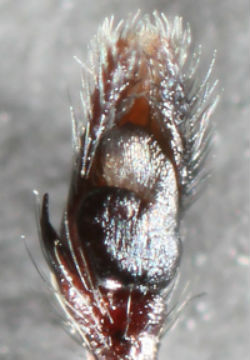Spider Anatomy
Online Biology Dictionary
|
|
Basic Spider Anatomy

|
|
Magnified spider fang. The
hairy region below is the
proximal segment of the
chelicera. |

|
|
Spider eyes ( Enlarged image) Credit: Opoterser |

|
|
Spider anatomy: (1) Walking legs; (2) cephalothorax; (3) abdomen |

|
| Pedipalp of a spider (Zygoballus rufipes) |
The body structure of spiders has certain features in common with that of other arachnids, in particular, two body segments, and eight walking legs. In addition, all arachnids lack antennae and wings. They have simple eyes, and a chitinous exoskeleton. In addition, arachnids have cartilaginous endoskeletons with attached muscles.
The first body segment is the cephalothorax (or prosoma), the second is the abdomen (or ophisthosoma). The cephalothorax bears the appendages and is covered dorsally by a tough carapace. The bodies of spiders range in size from about 1 mm up to 9 cm.
In spiders, the first pair of appendages, the chelicerae, are like two-segment fingers, the outer segment being a hollow fang that injects venom—virtually all spiders have poison glands, though some are far more venomous than others.
The second pair of appendages, the pedipalps, vary in length, depending on the type of spider in question. In tarantulas, they are like short legs. Male spiders use their pedipalps for insemination.
The abdomen, which is mounted on a flexible pedicle allowing movement relative to the cephalothorax, is thin-skinned and limbless. Within it, the gut has many branches (see figure below), which increase the area for absorption of nutrients.
The spinnerets are adjacent to the anus. They excrete the liquid protein produced by the silk glands, which hardens on contact with air.
Most spiders have four pairs of eyes, symmetrically placed. However, the number of eyes, when present, varies from two to eight (some cave spiders lack eyes). Their eyes have single lenses, unlike the typical insect, which has compound eyes. Many spiders, in particular, those that build webs, have acute night vision, better than that of a cat.
Diagram of spider anatomy:
 Image: John Henry Comstock
Image: John Henry Comstock